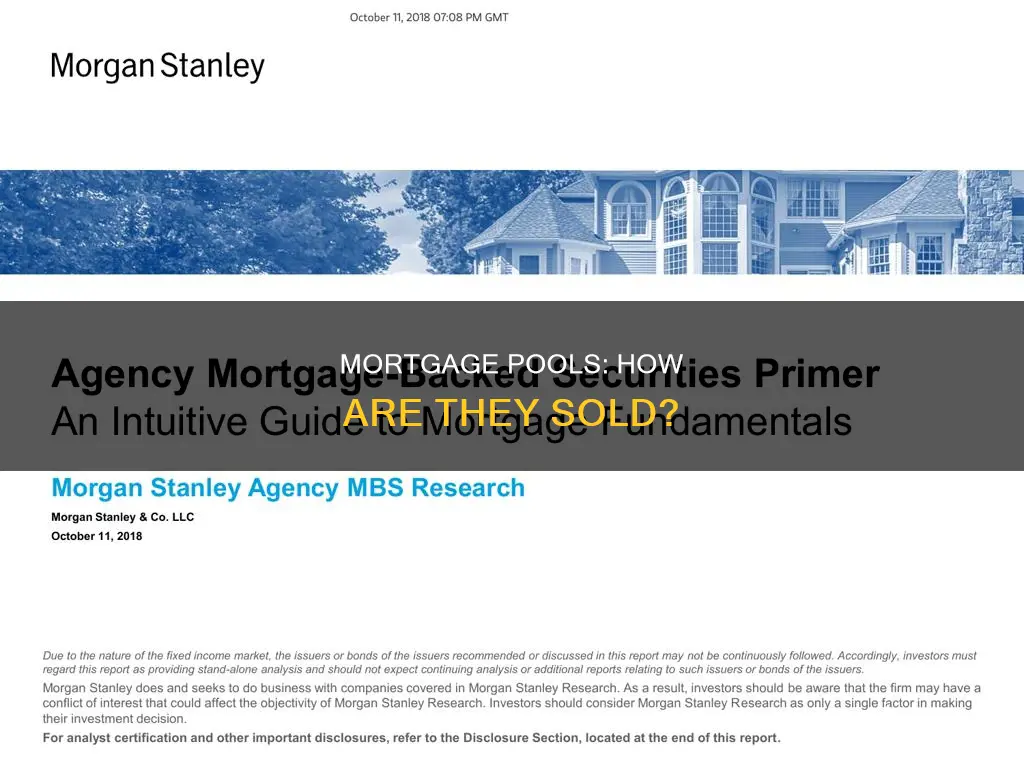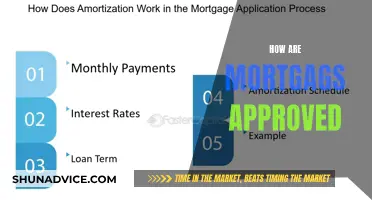
Mortgage pools are a group of mortgages held in trust as collateral for the issuance of a mortgage-backed security. They are created from a variety of loans, which are then bundled and sold to different entities on the secondary mortgage market. The mortgages within the pool tend to have similar characteristics, such as issuance dates, maturity dates, and property type. Mortgage pools are also known as mortgage-backed securities (MBS) and are considered a relatively low-risk investment due to government backing. MBS pool numbers are used to identify different types of pools, which are crucial for investors to understand before investing.
| Characteristics | Values |
|---|---|
| What is a mortgage pool? | A group of mortgages held in trust as collateral for the issuance of a mortgage-backed security. |
| Who are they sold to? | A trust, a GSE like Fannie Mae, Freddie Mac, a government agency like Ginnie Mae, or a private financial institution. |
| What happens after they are sold? | The trust then structures these loans into mortgage-backed securities (MBS). |
| What are MBS? | An investment like a bond that consists of a bundle of home loans bought from the banks that issued them. |
| What happens after MBS are issued? | The MBS are issued and sold to investors. The securities are backed by mortgage loans in the pool. |
| What happens after MBS are sold? | A mortgage servicer collects monthly mortgage payments from borrowers and distributes these payments to MBS investors. |
| What do investors get in return? | Investors receive periodic payments, including interest and principal repayments from the underlying mortgages. |
| What are the risks associated with MBS? | Prepayment risk, credit risk, market liquidity, and negative convexity. |
| What are the benefits of MBS? | MBS offers a stable monthly income, diversification, and a favourable Sharpe ratio. |
What You'll Learn

Mortgage pools are sold on the secondary mortgage market
The mortgages within the pool have similar characteristics, such as issuance dates and maturity dates. They can also be grouped according to other characteristics, such as property type, which can cause varying risks and returns. For example, if one location is experiencing a weak housing market, other locations in the pool that are not suffering from the same soft market can help balance out the collateral underlying the MBS.
Once the mortgages have been packaged together into a security, they are sold to investors. The cash flows from the underlying mortgages are passed through to the investors who own the MBS. Investors receive regular payments from the mortgages in the pool, based on the interest and principal payments made by the homeowners.
Mortgage-backed securities are considered a relatively low-risk investment, given the government backing for most of them. If an MBS is guaranteed by the federal government, investors do not have to absorb the costs of a borrower's default.
Trulia Mortgage Estimates: How Reliable Are They?
You may want to see also

They are sold as mortgage-backed securities (MBS)
Mortgage pools are sold as mortgage-backed securities (MBS), which are asset-backed securities formed by pooling together mortgages. The investor who buys an MBS is essentially lending money to homebuyers. MBSs are often sold to investors by government-sponsored enterprises like Fannie Mae, Freddie Mac, or Ginnie Mae, or they can be "private-label", issued by structures set up by investment banks.
The process of securitization is complex and depends on the jurisdiction in which it is conducted. In general, it involves distributing risk and allowing investors to choose different levels of investment and risk. The basic steps are as follows: origination, where a financial institution, such as a bank, provides mortgages to homebuyers; pooling, where the bank and other institutions pool many of these mortgage loans; securitization, where the pooled mortgages are sold to a trust, a GSE like Fannie Mae, Freddie Mac, a government agency like Ginnie Mae, or a private financial institution; issuance, where the MBS are issued and sold to investors. The securities are backed by mortgage loans in the pool.
Mortgage-backed securities can be divided into two broad types: pass-throughs and collateralized mortgage obligations (CMOs). Pass-throughs are structured as trusts in which mortgage payments are collected and passed to investors. They typically have stated maturities of five, 15, or 30 years. Collateralized mortgage obligations (CMOs) consist of multiple pools of securities known as slices or tranches, with different maturities and priorities in the receipt of the principal and interest. The tranches are given credit ratings, which determine the rates returned to investors.
The MBS market in the US has more than $11 trillion in outstanding securities and almost $300 billion in average daily trading volume. As of 2021, the volume of MBSs outstanding in the US surpassed $12 trillion, marking significant growth in the market size.
Bonds and Mortgage-Backed Securities: What's the Common Link?
You may want to see also

MBS are issued by government-sponsored entities (GSEs)
Mortgage-backed securities (MBS) are a type of asset-backed security or "instrument" that is secured by a mortgage or a collection of mortgages. MBS are issued by government-sponsored entities (GSEs) such as the Government National Mortgage Association (GNMA or Ginnie Mae), the Federal National Mortgage Association (FNMA or Fannie Mae), and the Federal Home Loan Mortgage Corporation (Freddie Mac). These agencies securitize mortgage pools—they convert them into securities that represent claims on the principal and interest payments made by the borrowers within the pool. The securitized mortgage pools are then sold on the secondary mortgage market.
GSEs are financial services corporations created by the United States Congress to enhance the flow of credit to targeted sectors of the economy, particularly real estate. They do not lend money to consumers but instead guarantee certain loan products, making financing more widely available and affordable. GSEs also issue short- and long-term bonds (agency bonds) that carry the implicit backing of the US government.
Mortgage pools are created from a variety of loans, which are grouped together and sold as a collection or pool. The funds in a mortgage pool are diversified, making them less vulnerable to risk than some other investments. The mortgages within a pool tend to have similar characteristics, such as issuance date and maturity date, and property type.
MBS are a common investment security, and the Fed has a program to purchase MBS from GSEs to prevent their bankruptcy and support the mortgage and housing markets. MBS can be purchased on the secondary mortgage market by institutional investors, private firms, and governmental and quasi-governmental entities.
Closing Costs: Who Pays What in a Mortgage?
You may want to see also

MBS are also issued by private companies
Mortgage-backed securities (MBS) are investments like bonds that consist of a bundle of home loans and other real estate debt bought from the banks that issued them. MBSs are also issued by private companies, known as "private-label" MBSs. These are issued by investment banks or private financial institutions. Issuances of private-label MBSs increased dramatically from 2001 to 2007 and then ended abruptly in 2008 when real estate markets began to falter.
An example of a private-label issuer is the real estate mortgage investment conduit (REMIC), a tax-structure entity usually used for CMOs. A REMIC structure avoids so-called double taxation. MBSs were national and international in scope and regionally diversified, unlike the traditional, localized and inefficient mortgage market.
MBSs are created when mortgage loans are purchased from banks and other lenders and assigned to a special purpose vehicle (SPV). The purchaser or assignee then assembles these loans into collections or "pools". The purchaser or assignee securitizes the pools by issuing MBSs. While a residential mortgage-backed security (RMBS) is secured by single-family, one- to four-unit real estate, a commercial mortgage-backed security (CMBS) is secured by commercial and multi-family properties, such as apartment buildings, retail or office properties.
The MBS market has evolved significantly since the 2007-2008 financial crisis, which was largely triggered by the collapse of the subprime mortgage market and the complex web of MBS and related derivatives. Today, the MBS market remains a major part of the global financial system, albeit with new regulations and increased scrutiny from investors and policymakers.
Mortgage Estimates: How Accurate Are These Calculations?
You may want to see also

MBS are considered relatively low-risk investments
Mortgage-backed securities (MBS) are investments secured by a group of mortgages. MBSs are created when mortgage loans are purchased from banks and lenders and assigned to a special purpose vehicle (SPV). The purchaser or assignee then securitizes the loans by issuing MBS. MBSs are considered relatively low-risk investments due to several factors.
Firstly, MBSs offer diversification. They are backed by a diverse pool of mortgages on real estate assets, such as residential or commercial properties. This diversification reduces the overall risk of default, as it is spread across numerous mortgages and properties, rather than a single borrower or property. The geographic diversity of the mortgages in the pool can also help mitigate risk. For example, if one location experiences a weak housing market, other locations in the pool may have stronger markets, thus balancing out the collateral underlying the MBS.
Secondly, MBSs have government backing for most of them. This means that if an MBS is guaranteed by the federal government, investors are protected from absorbing the costs of a borrower's default. MBSs also typically pay a fixed interest rate that is higher than U.S. government bonds, and they offer monthly payouts, providing a stable and attractive income stream.
Thirdly, MBSs have extended maturities and pay fixed coupons, resulting in high duration. However, it is important to note that the duration of MBS is uncertain due to the potential for borrowers to prepay their loans at any time. Prepayment by borrowers can minimize returns as the principal is paid off before all possible interest has been accrued.
While MBSs are considered relatively low-risk, they are not without risks entirely. MBS prices are sensitive to changes in interest rates, and economic downturns can lead to increased mortgage defaults, resulting in losses for MBS investors. Additionally, the 2008 financial crisis, caused by the collapse of home values, demonstrated that MBSs are not risk-free.
Mortgage Application Assessments: What Lenders Look For
You may want to see also
Frequently asked questions
A mortgage pool is a group of mortgages held in trust as collateral for the issuance of a mortgage-backed security. Mortgage pools are created from a variety of loans, which makes them less vulnerable to risk than some other investments.
A mortgage-backed security (MBS) is a type of asset-backed security that is secured by a mortgage or collection of mortgages. MBS are often issued by government-sponsored entities (GSEs) like Fannie Mae and Freddie Mac, but they can also be issued by private companies.
Mortgage pools are sold to a trust, a GSE like Fannie Mae, Freddie Mac, a government agency like Ginnie Mae, or a private financial institution. The trust then structures these loans into MBS.
The MBS are issued and sold to investors. The securities are backed by mortgage loans in the pool. Investors buy MBS, effectively lending money to homebuyers in the pool. In return, they receive periodic payments, including interest and principal repayments from the underlying mortgages.
Credit risk, or the risk that borrowers will default on their mortgages, can impact the value of MBS pools. Prepayment risk, or the risk that homeowners will refinance their mortgages or pay them off early, can also affect the value of the securities. Market liquidity refers to the ease with which MBS pools can be bought and sold, and low liquidity can decrease the value of MBS pools.







